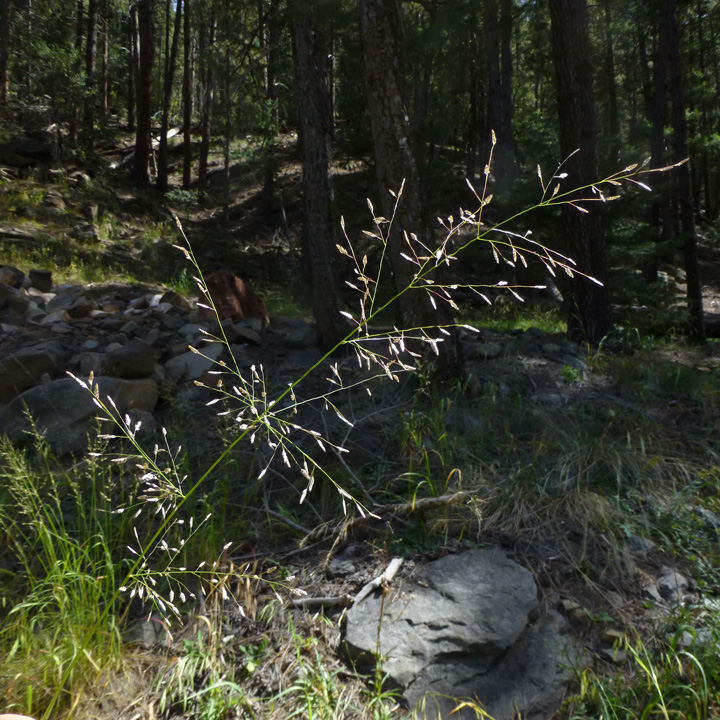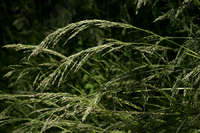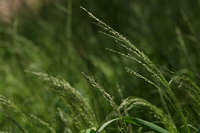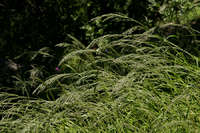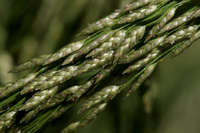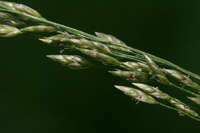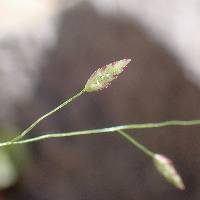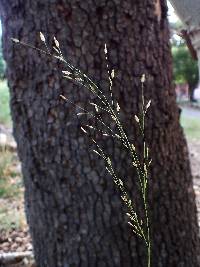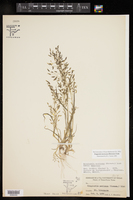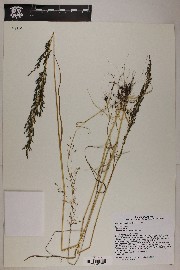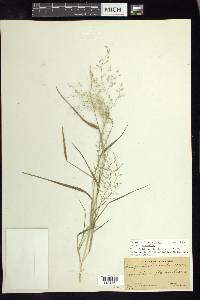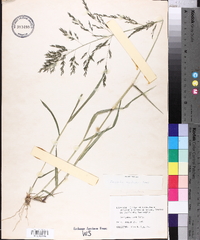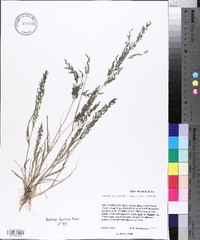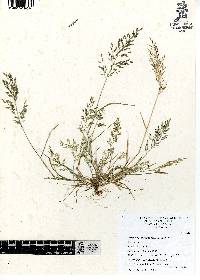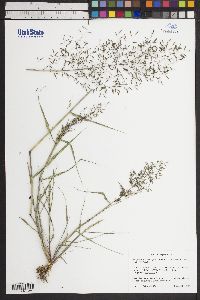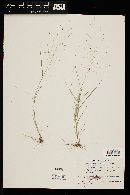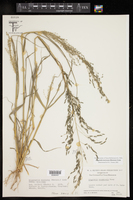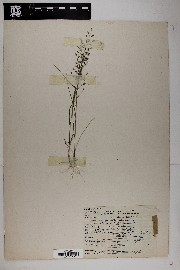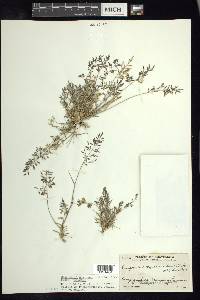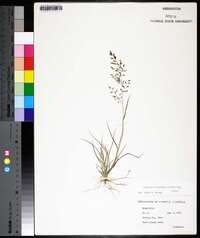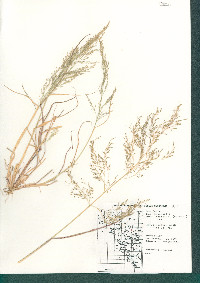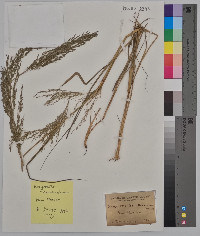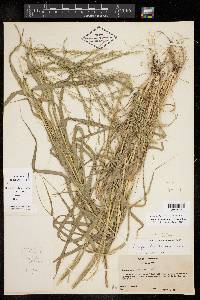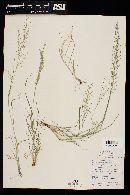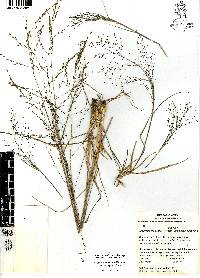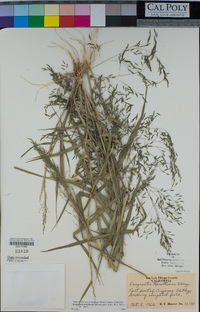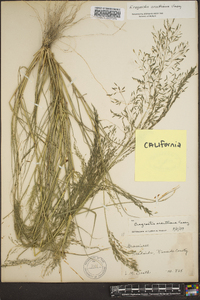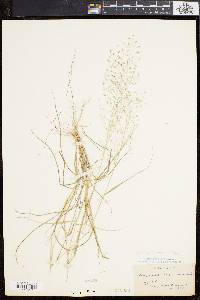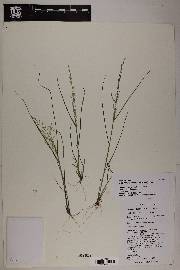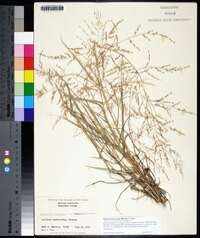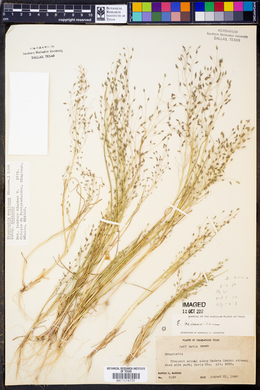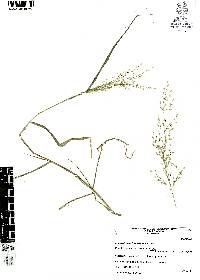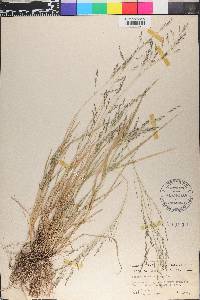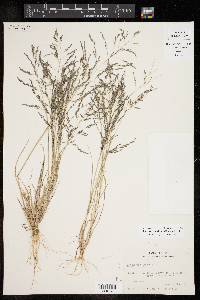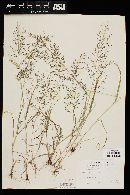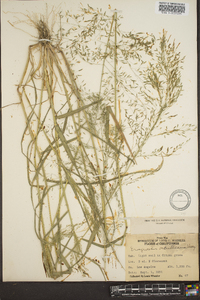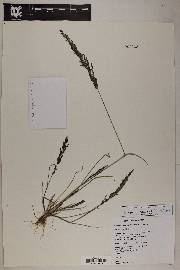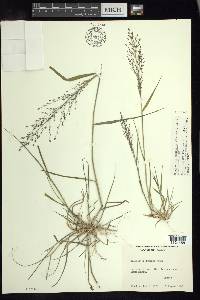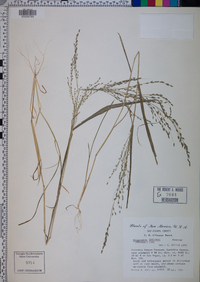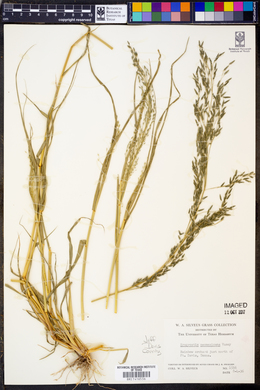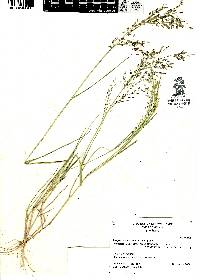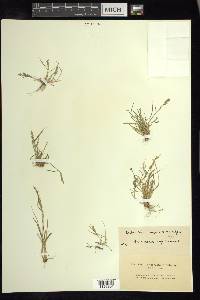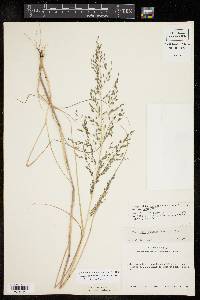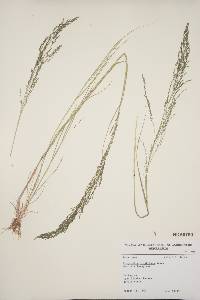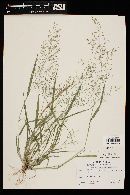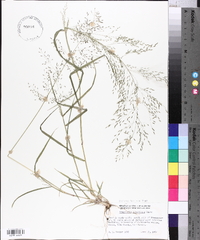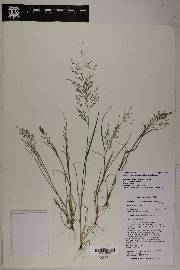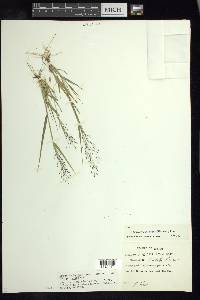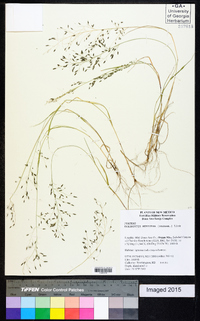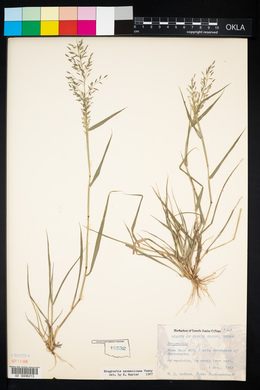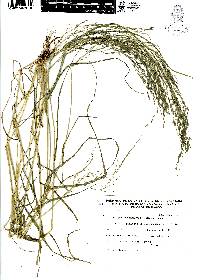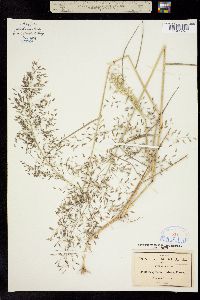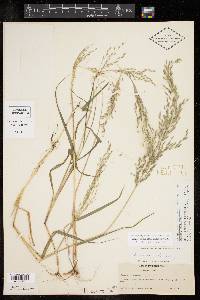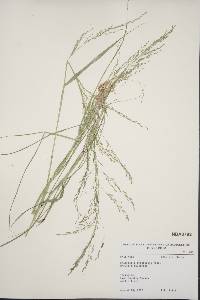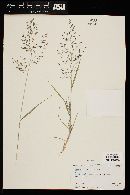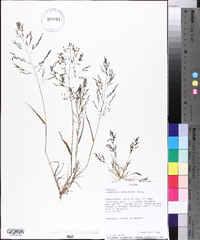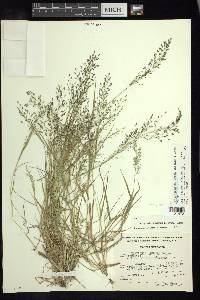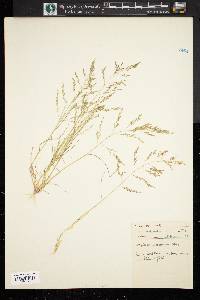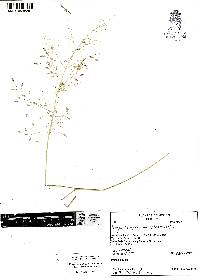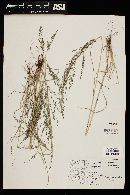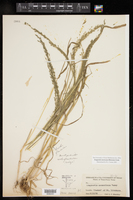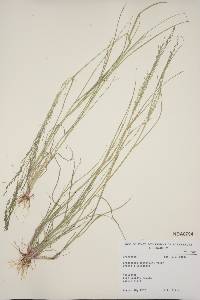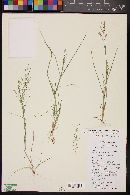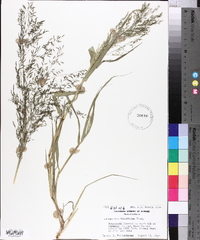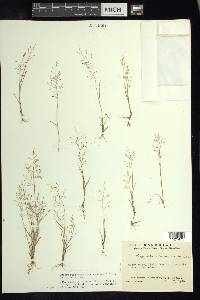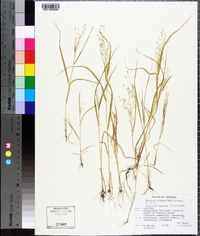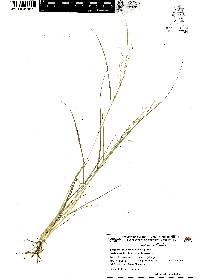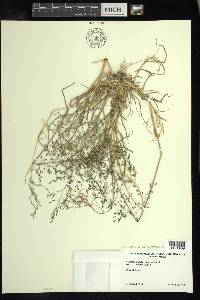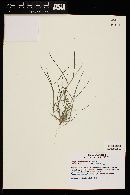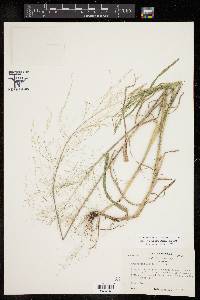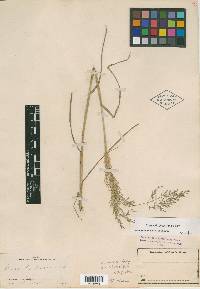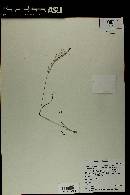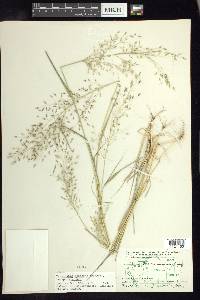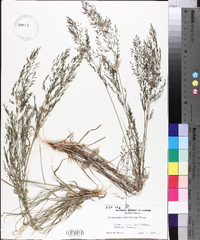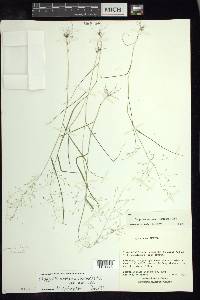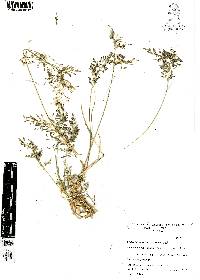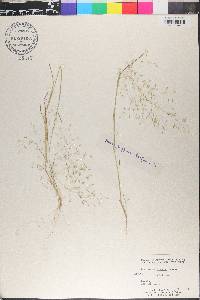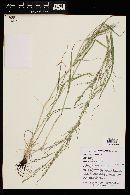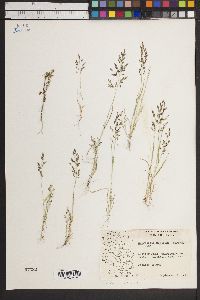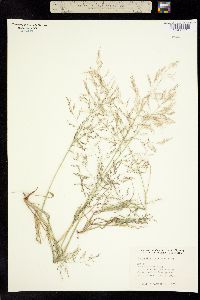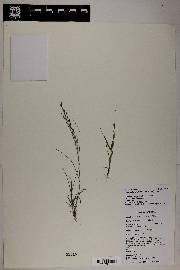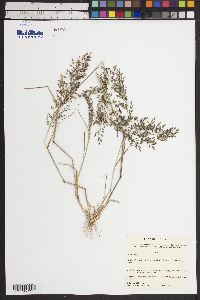Eragrostis mexicana
|
|
|
|
Family: Poaceae
Mexican Love Grass, more...Mexican lovegrass
[Eragrostis cordobensis Jedwabn., moreEragrostis leptantha Trin., Eragrostis limbata f. densiuscula Hack., Eragrostis limbata var. major E. Fourn., Eragrostis mexicana var. mexicana , Eragrostis mexicana var. pygmaea Döll, Eragrostis pauciflora Trin., Eragrostis purshii var. major E. Fourn., Eragrostis rahmeri Phil.] |
Plants annual; cespitose, without innovations. Culms 10-130 cm, erect, sometimes geniculate, glabrous, sometimes with a ring of glandular depressions below the nodes. Sheaths sometimes with glandular pits, pilose near the apices and on the collars, hairs to 4 mm, papillose-based; ligules 0.2-0.5 mm, ciliate; blades 5-25 cm long, 2-7(9) mm wide, flat, abaxial surfaces glabrous, adaxial surfaces scabridulous, occasionally pubescent near the base. Panicles (5)10-40 cm long, (2)4-18 cm wide, ovate, rachises angled and channeled; primary branches 3-12(15) cm, solitary to whorled, appressed or diverging to 80° from the rachises; secondary branches somewhat appressed; pulvini glabrous; pedicels 1-6(7) mm, almost appressed to narrowly divergent, stiff. Spikelets (4)5-10(11) mm long, 0.7-2.4 mm wide, ovate to linear-lanceolate, gray-green to purplish, with 5-11(15) florets; disarticulation acropetal. Glumes subequal, 0.7-2(2.3) mm, ovate to lanceolate, membranous; lemmas 1.2-2.4 mm, ovate, membranous, glabrous or with a few hairs, gray-green, lateral veins evident, often greenish, apices acute; paleas 1-2.2 mm, hyaline, keels scabrous, apices obtuse to truncate; anthers 3, 0.2-0.5 mm, purplish. Caryopses 0.5-0.8(1) mm, ovoid to rectangular-prismatic, laterally compressed, shallowly to deeply grooved on the adaxial surface, striate, reddish-brown, distal 2/3 opaque. 2n = 60. Eragrostis mexicana grows along roadsides, near cultivated fields, and in disturbed open areas, at 100-3000 m. It is native to the Americas, its native range extending from the southwestern United States through Mexico, Central and northern South America, to Argentina. Within the Flora region, it has been introduced beyond its native range, often becoming an established part of the flora. Annual tufted herb 10 cm - 1.7 m tall Leaves: with open sheaths that sometimes have glandular pits below the nodes and warty-based hairs (to 4 mm long) near the tips and on the collars, and 0.2 - 0.5 mm long ligules that are hairy along the margins. The blades are 5 - 25 cm long, 2 - 9 mm wide, flat, hairless beneath, minutely rough above, and sometimes hairy near the base. Inflorescence: terminal, branched (panicle), rising above the upper leaves, 5 - 40 cm long, 2 - 18 cm wide, egg-shaped, with an angled and grooved main axis and primary branches 3 - 15 cm long. Fruit: a caryopsis, reddish brown with the upper two-thirds opaque, 0.5 - 1 mm long, egg-shaped to rectangle-faced (prism-like) with flat ends, laterally compressed, longitudinally lined with a shallow to deep groove on one side. Culm: 10 cm - 1.3 m long, erect, sometimes with abrupt bends at nodes (geniculate), hairless, occasionally with a ring of glands beneath nodes. Spikelets: on a stiff stalk 1 - 7 mm long, grayish green to purplish, 4 - 11 mm long, 0.7 - 2.4 mm wide, egg-shaped to linear-lance-shaped, laterally compressed. Glumes: nearly equal, 0.7 - 2.3 mm long, egg-shaped to lance-shaped, membranous, single-veined, neither lobed nor awned. Florets: five to fifteen per spikelet, with three purplish anthers 0.2 - 0.5 mm long. Lemma: grayish green, 1.2 - 2.4 mm long, egg-shaped with a pointed tip, membranous, hairless or sparsely hairy, with apparent lateral veins. Palea: transparent, 1 - 2.2 mm long, with a blunt to squared tip and two rough longitudinal ridges. Similar species: Eragrostis capillaris, Eragrostis frankii, and Eragrostis mexicana are annuals with grooved caryopses (E. frankii is not always grooved). Eragrostis capillaris has shorter spikelets (to 5 mm) with fewer flowers (two to seven), three reddish brown anthers, and always deeply grooved caryopses. Eragrostis frankii sometimes has glands on the culm and inflorescence branches, the spikelets are shorter (1.7 - 5.6 mm long) and have fewer florets (three to six), and the purple anthers are found two or three per floret. Flowering: July to October Habitat and ecology: Introduced from the western United States, this species is very rare in the Chicago Region. Occurence in the Chicago region: non-native Etymology: Eragrostis is derived from the name of the Greek god of love, Eros, and agrostis, meaning grass. Mexicana means Mexican. Author: The Morton Arboretum FNA 2003, Gould 1980 Common Name: Mexican lovegrass Duration: Annual Nativity: Native Lifeform: Graminoid General: Cespitose annual grass with erect stems 10-130 cm, sometimes geniculate, sometimes with a ring of glandular depressions below the nodes. Vegetative: Sheaths sometimes with glandular pits, pilose near the apices and on the collars, hairs to 4 mm; ligules a dense row of hairs, 0.2-0.5 mm; blades 5-25 cm long, 2-7 mm wide, flat, with glabrous surfaces below, minutely roughened above, occasionally pubesce Inflorescence: Panicles 10-40 cm long, 4-18 cm wide, ovate, with angled and channeled rachises; primary branches solitary to whorled, appressed or up to 80 degrees from rachises; secondary branches often somewhat appressed as well; pedicels 1-6 mm, almost appressed to narrowly divergent and stiff; spikelets 5-10 mm long, 1-2 mm wide, ovate to linear-lanceolate, gray-green to purplish with 5-11 florets; glumes subequal, 0.5-2 mm, ovate to lanceolate; lemmas 1-2.5 mm, ovate, glabrous or with a few hairs, lateral veins evident; caryopses up to 1 mm, laterally compressed, grooved on upper surface, reddish brown. Ecology: Found on sandy soils, often in disturbed areas; 500-10,000 ft (152-3048 m); flowers August to October. Distribution: Much of Western N. America, from CAN south through MEX into S. America; introduced to S. Africa, Australia and Europe. Notes: Eragrostis species have branched inflorescences (panicles); multiple, bisexual flowers (florets) per spikelet; and components of the spikelets are for the most part hairless and awnless. This species distinguished by being an annual with ascending, usually contracted panicle branches topped by spikelets that are almost ovoid when immature, and open at anthesis. Distinguish from E. pectinacea based on the reddish-brown hue at the base of the stems; the deep, central groove on the seed; and the long hairs at the tops of the leaf sheaths (vs. short hairs in E. pectinacea). Distinguish from E. cilianensis based on the lack of a strong smell, and the spikelets are much more slender, at 1-2 mm wide (2-3 mm wide in E. cilianensis). Ethnobotany: Seeds were ground and the flour was cooked in mush. Etymology: Eragrostis is from Greek eros, love and agrostis, grass, while mexicana means of or from Mexico. Synonyms: None Editor: SBuckley 2010, FSCoburn 2014, AHazelton 2015 Link and its close relative E. neomexicana Vasey, both with the grain furrowed as in E. capillaris, are rarely and sporadically adventive with us. Both differ from E. capillaris in their proportionately smaller and more congested infl and 7-15-fld spikelets with larger lemmas (1.7+ mm). E. neomexicana is robust under favorable conditions, 5-12 dm, with lvs 3-10 mm wide, and commonly has a ring of yellow glands below each node of the stem and glandular pits on the sheath (at least along the keel). E. mexicana averages smaller, seldom over 5 dm, with lvs 3-6 mm wide, and lacks the glands. Gleason, Henry A. & Cronquist, Arthur J. 1991. Manual of vascular plants of northeastern United States and adjacent Canada. lxxv + 910 pp. ©The New York Botanical Garden. All rights reserved. Used by permission. |
|
|
|

